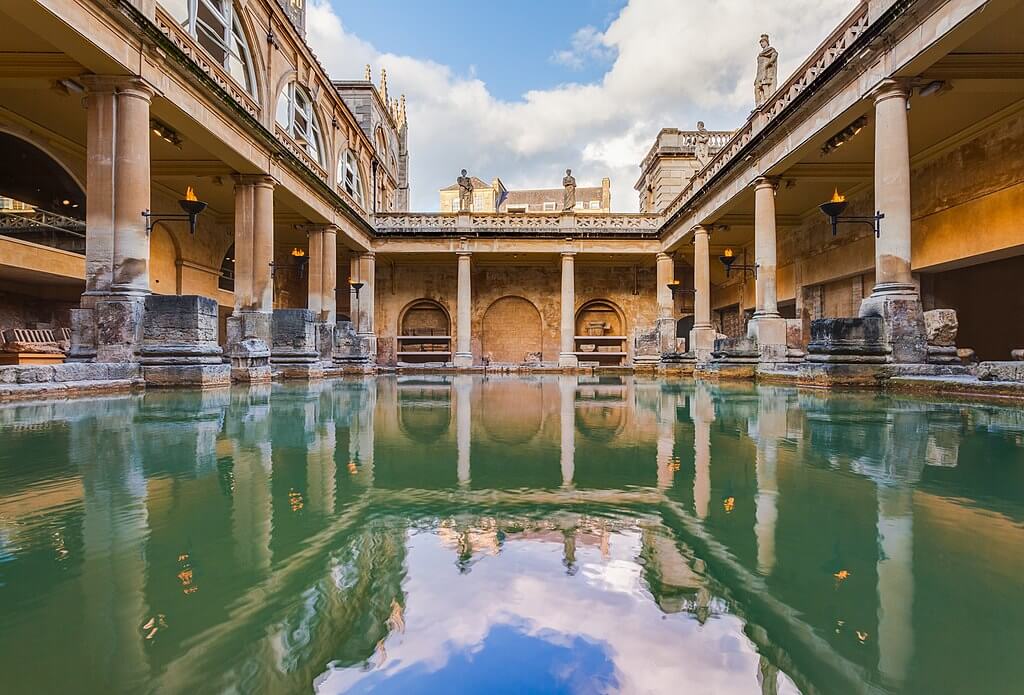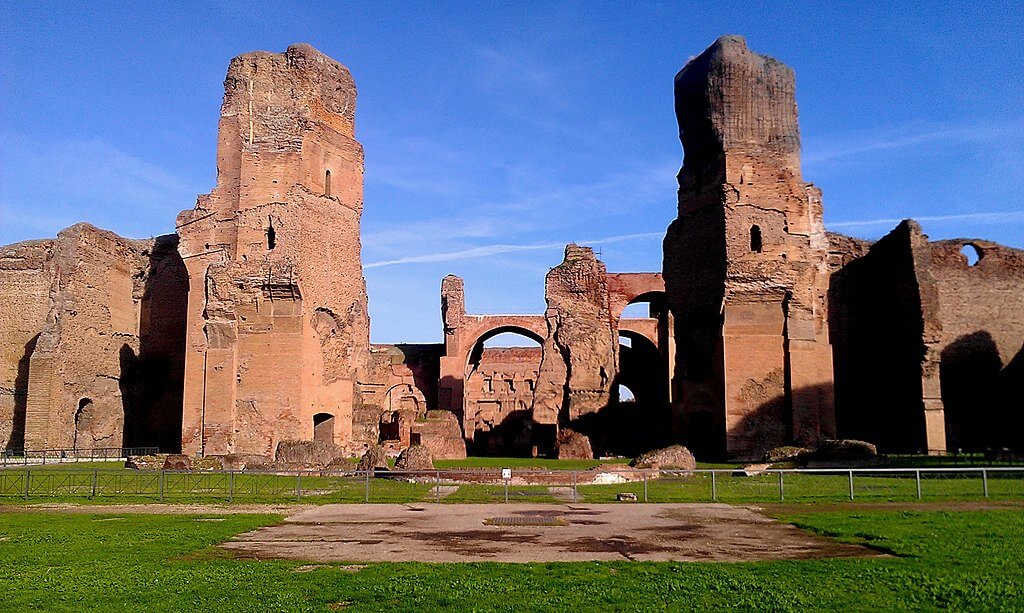“Baths in Ancient Rome” represented a fascinating fusion of public utility and grandeur, becoming an integral part of daily life. From simple communal bathhouses to the elaborate thermae, these structures were a testament to the Roman culture’s emphasis on cleanliness, socialization, and architectural sophistication.
The Importance of Bathing in Roman Society
Bathing held a significant place in ancient Roman society, seen not merely as a means for cleanliness, but also as a cultural ritual with social, political, and even religious dimensions. The act of bathing was intertwined with daily activities, allowing individuals of all classes to engage in shared routines, reflecting the importance of communal interaction in Roman society.
In stark contrast to modern perceptions of bathing as a private act, Roman baths were vast public spaces where hundreds, sometimes even thousands, would gather daily. These establishments offered a variety of services, from hot and cold baths to gymnasiums, libraries, and gardens, becoming central meeting places for all strata of society. They were venues for socialization, networking, conducting business, relaxation, and leisure. The rich would flaunt their wealth through extravagant bath parties while the commoners utilized these spaces for their essential grooming needs, turning baths into a vibrant hub of Roman communal life.
Moreover, baths in Roman society also had a political aspect. Emperors and politicians would construct elaborate baths, known as thermae, as a demonstration of their wealth and power. By providing such luxurious public amenities, rulers could foster goodwill and gain popularity among their subjects, making bathhouses an essential part of the Roman political landscape.
The religious component of bathing in Roman society shouldn’t be overlooked either. Many bath complexes were located near temples and included their own small shrines. Ritual purification was a common element in ancient religions, and the Romans often integrated religious ceremonies with their bathing practices, further demonstrating the complex social and cultural role that bathing played in Ancient Rome.
The Bathing Rituals of Ancient Romans: Practices and Procedures
Ancient Romans followed a specific sequence of bathing practices that reflected their understanding of hygiene, health, and body care. A typical visit to the bathhouse was not simply immersing oneself in water, but a process that involved several stages and different rooms.
A Roman would begin in the ‘apodyterium’, a changing room where bathers would undress and leave their clothes. Slaves often accompanied the wealthy to guard their belongings and assist them through the process. Following this, Romans would move to the ‘palaestra’, an open-air courtyard for exercise. Here, they would engage in physical activities like wrestling or ball games, as sweating was seen as a crucial part of the cleansing process.
After working up a sweat, bathers would proceed to the ‘tepidarium’, a moderately warm room that prepared their bodies for the high temperatures of the next stage. This was followed by a visit to the ‘caldarium’, the hottest room in the bathhouse, heated by a hypocaust, an underfloor heating system. In this room, bathers would perspire profusely, which was believed to purge the body of impurities.
Next, bathers would get a ‘strigil’, a curved metal tool, to scrape off the sweat, dirt, and dead skin. Oil was often applied before this stage to facilitate the scraping process. After this vigorous cleaning, bathers would plunge into the ‘frigidarium’, a pool of cold water, to close their pores and refresh their bodies.
To complete the bathing experience, there was often a final stage, the ‘laconicum’, a dry, sweating room for a last bit of perspiration. After all these stages, bathers would dress and proceed to social areas of the bathhouse, like gardens, libraries, or even lecture halls for intellectual pursuits.
These rituals underscored the Roman belief in the baths’ restorative power, with the process involving not just cleanliness, but also relaxation, rejuvenation, and overall health. Bathing, to the Romans, was a total sensory experience, and their methodical rituals clearly illustrate this view.
Greek and Oriental Influence on Roman Bath Development
The Romans were renowned for their engineering prowess, creating monumental structures and complex systems for public use. However, their bath culture, while distinctively Roman in many aspects, had roots in other ancient cultures, most notably the Greeks and various Oriental societies.

Greek influence on Roman baths was evident early on. The Romans borrowed the concept of public baths from the Greeks, who believed in the close relationship between physical cleanliness and spiritual purity. The Greeks’ emphasis on the aesthetic beauty of the human body and physical fitness also resonated with the Romans, who incorporated gymnasiums and exercise spaces into their bathhouses. Additionally, the Greek tradition of intellectual discussions in bathhouses influenced the Roman inclusion of libraries and lecture halls in their thermae, integrating mental stimulation with physical relaxation.
Oriental societies, particularly from regions like Egypt and Persia, contributed to the development of Roman baths as well. For example, the hypocaust system used in Roman baths bears similarities to the heating system in Persian structures. Furthermore, the Oriental practice of hot-air bathing influenced the Romans’ adoption of steam rooms in their bathing facilities.
These foreign influences were synthesized with Roman engineering, architecture, and societal needs to create the unique bathing culture of Ancient Rome. The Romans didn’t merely copy these practices; instead, they absorbed, adapted, and enhanced them to suit their lifestyle, societal structure, and aesthetic preferences. This cultural exchange is a clear testament to the Romans’ capacity for innovation and their openness to foreign ideas, ultimately resulting in the complex and sophisticated bathhouses that were cornerstones of Roman society.
Architectural Description of Roman Baths: Structure and Functionality
Roman bathhouses, also known as thermae, were significant architectural feats, showcasing the ingenuity and aesthetic sensibilities of Roman society. These structures combined function with artistry, offering facilities for both bathing and social activities while showcasing intricate designs and decor.
The layout of a typical Roman bathhouse was quite complex, with rooms arranged in a logical sequence to facilitate the bathing ritual. Upon entry, bathers would find the apodyterium, a large changing room. This would lead to the palaestra, an exercise area that was often open-air and might include a swimming pool. Next in line were the bathing rooms, starting with the tepidarium, or warm room, followed by the caldarium, or hot room, and then the frigidarium, or cold room.

One of the most striking features of Roman bathhouses was the hypocaust system. This underfloor heating technique involved a raised floor, supported by pillars, with spaces for hot air to circulate beneath. Furnaces would heat the air, which would then rise and warm the floor and the room above. Walls were also constructed with hollow spaces for hot air circulation, ensuring the room was heated evenly.
Apart from the bathing facilities, Roman bathhouses often included other amenities, such as libraries, lecture halls, and even shops, catering to the social and intellectual needs of the bathers. Many bathhouses also had outdoor areas with gardens and decorative fountains, enhancing their aesthetic appeal.
The architecture of Roman baths was also notable for its artistry. Many bathhouses featured detailed mosaics, elaborate sculptures, and decorative stucco work. They often had high, vaulted ceilings, large windows, and were built using a variety of materials, including marble, which added to their grandeur.
Roman baths were more than mere utilitarian structures; they were complex facilities that reflected the architectural prowess, societal habits, and aesthetic tastes of the Romans. Their design, scale, and sophistication reveal a great deal about the importance of public bathing culture in ancient Rome.
Preserved Roman Baths: Testimonies of Ancient Roman Bathing Culture
There are several preserved Roman baths across the world that serve as enduring testimonies to the bathing culture of Ancient Rome. These well-preserved structures offer invaluable insights into the rituals, societal norms, and architectural advancements of the period.
Perhaps the most famous of these are the Baths of Caracalla in Rome. Built-in the 3rd century AD, they were one of the largest and most opulent bathhouses of the time. The complex boasted a myriad of facilities, including a central frigidarium, surrounding tepidarium and caldarium, two palaestrae for exercise, libraries, and even a theatre. The remnants of the Baths of Caracalla showcase the grandeur of Roman thermae, with well-preserved mosaics, sculptures, and the colossal remains of the central bathing hall.
Another prominent example is the Roman Baths in the city of Bath, England. The site is renowned for its remarkably preserved Great Bath, a large pool filled with water from Bath’s natural hot springs. The complex also includes the ruins of the temple of Sulis Minerva, demonstrating the blend of bathing and religious practices in Roman society. Today, the Roman Baths of Bath serve as a popular museum, immersing visitors in the world of Roman Britain.

In addition to these, other preserved Roman baths include the Baths of Diocletian in Rome, the Antonine Baths in Carthage, Tunisia, and the Stabian Baths in Pompeii, among others. Each of these sites offers a unique glimpse into the Roman world, underscoring the integral role of baths in societal life.
These surviving bathhouses, though mere remnants of their original grandeur, provide tangible links to the past. They allow us to understand the scale, design, and importance of these facilities, providing a clearer picture of the bathing culture in Ancient Rome. They stand as testimonials of the Roman Empire’s architectural prowess, cultural practices, and societal norms.
Historical Challenge: Can You Conquer the Past?
Answer more than 18 questions correctly, and you will win a copy of History Chronicles Magazine Vol 1! Take our interactive history quiz now and put your knowledge to the test!

